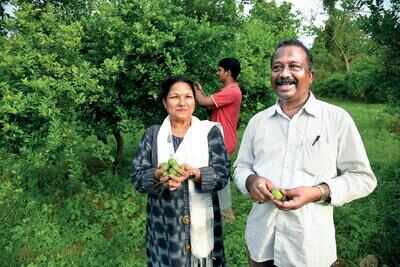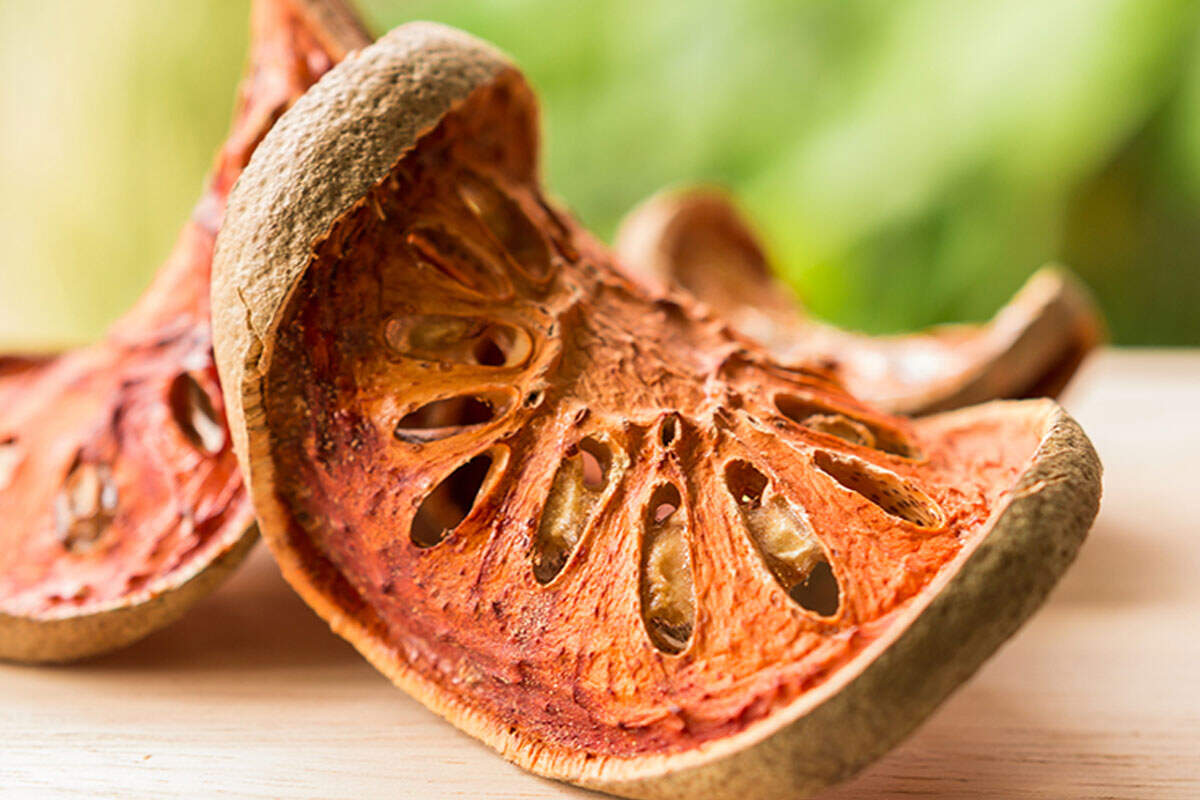
Wanoda (Umred): Spraying a mix of green chilli, turmeric, garlic and tobacco paste diluted in 100 litres of water can ward off pest attacks. If true, it may indeed give corporate giants making pesticides a run for their money. Etymologists may find it illogical, but Vivek Malvi, who has a 20-acre farm in vicinity of Umred Karhandla Tiger Reserve, says the dose could cure the lemon trees on his land of a bacterial infection that had left the fruit discoloured.
An electrical engineer who opted for early retirement from the Airports Authority of India (AAI), Malvi grows paddy, amla (Indian gooseberry) and lemon at Wanoda village in Umred Tehsil. He says the ‘Agniastra’ had a miraculous impact on the trees infested with citrus canker, a major pest hitting lemon and mosambi (sweet lime) trees.
‘Agniastra’ is one of the types of pesticides made out of household items like chilli and garlic as prescribed by Subhash Palekar, the proponent of natural farming. Palekar’s method is being seen as a means to increase farmers’ income by Niti Aayog. Again, like many others, Malvi is the only farmer in the village following natural farming. For many others, wildlife like boars and nilgai destroying the crop is a bigger problem than increasing output.
Among the stronger variants of natural pesticides, ‘Agniastra’s’ use is recommended only if the pest attack is intense. Malvi shifted to Subhash Palekar Natural Farming (SPNF) a year ago. The impact which ‘Agniastra’ had on the pest has further strengthened his belief on SPNF.
Canker is a bacterial infestation that leaves spots on the fruits’ peel due to which it does not fetch a proper price and at times the produce has to be discarded. “The paste was mixed in 100 litres of water and sprayed on the trees and it had an immediate affect. Not only the fruits that came next were not infected, but also had a better fragrance and sheen,” says Malvi.
His 27-year-old son, Akshay, who has a degree in agricultural sciences, could not explain how exactly chilli and garlic paste would have helped in eliminating the bacteria. “May be due to its inflammability, but I cannot exactly identify the element in ‘Agniastra’ that would have acted against canker,” says Akshay explaining how harmful chemicals can be.
Dinkar Nath Garg, a former scientist in the National Citrus Research Centre (NRCC), a unit under the Indian Council for Agricultural Research (ICAR), was sceptical. “Canker infestation leads to occurrence of spots on lemon. It starts with infesting the leaf and eventually the fruit. The disease is normally cured with chemical-pesticides like copper oxychloride and streptocycline. The infestation only affects the fruits’ skin and not beyond,” he said.
Garg said the antidote may have only acted as a repellent but could not have eliminated the bacteria. Palekar too said his method stresses on only repelling the pests. “There is no need to kill the natural soil rejuvenators. I recommend providing enough strength to the plant to fight pests on its own,” he told TOI.
Malvi says he got to know about the Palekar method through a friend working in the Babha Atomic Research Centre (BARC), after which he attended one of his sessions.
Malvi is now building a house right at the farm so that he can supervise the farm hands on carrying out farming the Palekar way. “We had been growing paddy here, but I noticed that the output was constantly dropping. After that, I shifted to SPNF last year. The yield came down but the margin of profit was tripled,” he says. Malvi now plans to shift to growing vegetables instead of paddy.
An electrical engineer who opted for early retirement from the Airports Authority of India (AAI), Malvi grows paddy, amla (Indian gooseberry) and lemon at Wanoda village in Umred Tehsil. He says the ‘Agniastra’ had a miraculous impact on the trees infested with citrus canker, a major pest hitting lemon and mosambi (sweet lime) trees.
‘Agniastra’ is one of the types of pesticides made out of household items like chilli and garlic as prescribed by Subhash Palekar, the proponent of natural farming. Palekar’s method is being seen as a means to increase farmers’ income by Niti Aayog. Again, like many others, Malvi is the only farmer in the village following natural farming. For many others, wildlife like boars and nilgai destroying the crop is a bigger problem than increasing output.
Among the stronger variants of natural pesticides, ‘Agniastra’s’ use is recommended only if the pest attack is intense. Malvi shifted to Subhash Palekar Natural Farming (SPNF) a year ago. The impact which ‘Agniastra’ had on the pest has further strengthened his belief on SPNF.
Canker is a bacterial infestation that leaves spots on the fruits’ peel due to which it does not fetch a proper price and at times the produce has to be discarded. “The paste was mixed in 100 litres of water and sprayed on the trees and it had an immediate affect. Not only the fruits that came next were not infected, but also had a better fragrance and sheen,” says Malvi.
His 27-year-old son, Akshay, who has a degree in agricultural sciences, could not explain how exactly chilli and garlic paste would have helped in eliminating the bacteria. “May be due to its inflammability, but I cannot exactly identify the element in ‘Agniastra’ that would have acted against canker,” says Akshay explaining how harmful chemicals can be.
Dinkar Nath Garg, a former scientist in the National Citrus Research Centre (NRCC), a unit under the Indian Council for Agricultural Research (ICAR), was sceptical. “Canker infestation leads to occurrence of spots on lemon. It starts with infesting the leaf and eventually the fruit. The disease is normally cured with chemical-pesticides like copper oxychloride and streptocycline. The infestation only affects the fruits’ skin and not beyond,” he said.
Garg said the antidote may have only acted as a repellent but could not have eliminated the bacteria. Palekar too said his method stresses on only repelling the pests. “There is no need to kill the natural soil rejuvenators. I recommend providing enough strength to the plant to fight pests on its own,” he told TOI.
Malvi says he got to know about the Palekar method through a friend working in the Babha Atomic Research Centre (BARC), after which he attended one of his sessions.
Malvi is now building a house right at the farm so that he can supervise the farm hands on carrying out farming the Palekar way. “We had been growing paddy here, but I noticed that the output was constantly dropping. After that, I shifted to SPNF last year. The yield came down but the margin of profit was tripled,” he says. Malvi now plans to shift to growing vegetables instead of paddy.
World Cup 2019
Trending Topics
LATEST VIDEOS
More from TOI
Navbharat Times
Featured Today in Travel
Quick Links
Lok Sabha Election Schedule 2019Lok Sabha Election NewsDelhi Capitals teamMI team 2019Rajasthan Royals 2019RCB team 2019Maharashtra Lok Sabha ConstituenciesBJP Candidate ListBJP List 2019 TamilnaduShiv Sena List 2019AP BJP List 2019Mamata BanerjeeBJP List 2019 MaharashtraPriyanka GandhiBJP List 2019 KarnatakaAMMK Candidate List 2019BJP List 2019 WBLok Sabha Elections in Tamil NaduBSP List 2019 UPNews in TamilLok Sabha Poll 2019Satta Matka 2018PM ModiMahagathbandhanNagpur BJP Candidate ListChandrababu NaiduTamil Nadu ElectionsUrmila MatondkarNews in TeluguMadras High CourtTejashwi YadavArvind KejriwalTejasvi SuryaPawan KalyanArvind KejriwalYogi AdityanathJaya PradaSatta King 2019Srinagar encounter
Get the app







